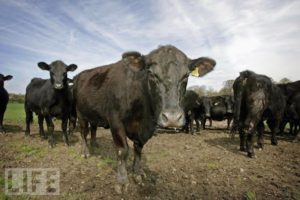Shiga toxin-producing Escherichia coli (STEC) is an important foodborne pathogen that can cause hemorrhagic colitis and hemolytic-uremic syndrome. Cattle are the primary reservoir for STEC, and food or water contaminated with cattle feces is the most common source of infections in humans.
 Consequently, we conducted a cross-sectional study of 1,096 cattle in six dairy herds (n = 718 animals) and five beef herds (n = 378 animals) in the summers of 2011 and 2012 to identify epidemiological factors associated with shedding.
Consequently, we conducted a cross-sectional study of 1,096 cattle in six dairy herds (n = 718 animals) and five beef herds (n = 378 animals) in the summers of 2011 and 2012 to identify epidemiological factors associated with shedding.
Fecal samples were obtained from each animal and cultured for STEC. Multivariate analyses were performed to identify risk factors associated with STEC positivity. The prevalence of STEC was higher in beef cattle (21%) than dairy cattle (13%) (odds ratio [OR], 1.76; 95% confidence interval [CI], 1.25, 2.47), with considerable variation occurring across herds (range, 6% to 54%). Dairy cattle were significantly more likely to shed STEC when the average temperature was >28.9°C 1 to 5 days prior to sampling (OR, 2.5; 95% CI, 1.25, 4.91), during their first lactation (OR, 1.8; 95% CI, 1.1, 2.8), and when they were <30 days in milk (OR, 3.9; 95% CI, 2.1, 7.2). These data suggest that the stress or the negative energy balance associated with lactation may result in increased STEC shedding frequencies in Michigan during the warm summer months.
Future prevention strategies aimed at reducing stress during lactation or isolating high-risk animals could be implemented to reduce herd-level shedding levels and avoid transmission of STEC to susceptible animals and people.
STEC shedding frequencies vary considerably across cattle herds in Michigan, and the shedding frequency of strains belonging to non-O157 serotypes far exceeds the shedding frequency of O157 strains, which is congruent with human infections in the state. Dairy cattle sampled at higher temperatures, in their first lactation, and early in the milk production stage were significantly more likely to shed STEC, which could be due to stress or a negative energy balance. Future studies should focus on the isolation of high-risk animals to decrease herd shedding levels and the potential for contamination of the food supply.
Factors associated with Shiga toxin-producing Escherichia coli shedding by dairy and beef cattle
Cristina Venegas-Vargasa*, Scott Hendersona,b, Akanksha Khareb*,Rebekah E. Moscib, Jonathan D. Lehnertb*, Pallavi Singhb,Lindsey M. Ouelletteb*, Bo Norbya, Julie A. Funka, Steven Rustc, Paul C. Bartletta,Daniel Groomsa and Shannon D. Manningb
aDepartment of Large Animal Clinical Sciences, College of Veterinary Medicine, Michigan State University, East Lansing, Michigan, USA
bDepartment of Microbiology and Molecular Genetics, Michigan State University, East Lansing, Michigan, USA
cDepartment of Animal Science, Michigan State University, East Lansing, Michigan, USA
Applied and Environmental Microbiology, August 2016, Volume 82, Number 16, Pages 5049-5056, doi:10.1128/AEM.00829-16



